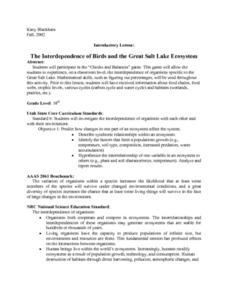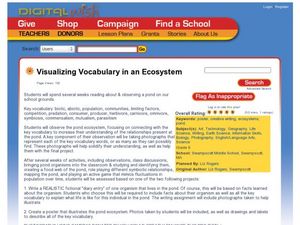Curated OER
Prokaryotes
The cellular and genetic organization of Prokaryotes, and the main characteristics of their movement and structure are summarized in this presentation. They are compared to Eukaryotes and that information will help your students with...
Curated OER
Kingdom: Fungi
The general characteristics of fungus types are presented here. Your class will love the pictures of the amazing features found on these strange living things. The internal and external structures and their functions are highlighted. By...
Curated OER
Kingdom: Fungi
The general characteristics that affect classification of fungi and other organisms in the domain Eukarya are detailed for the students on 12 attractive slides. Teachers can access individual slides to cover life cycles or diversity, or...
Curated OER
The Five Senses
Students participate in a scavenger hunt using their sense of sight. They bring various texture materials from home and discuss how things feel. Students identify the smells inside five jars. They discuss things they hear and why hearing...
Curated OER
Volcanoes of the Deep
Students discuss how organisms relate to one another. They work together to research a specific organism and how it relates to other organisms. They present their findings to the class.
Curated OER
The Interdependence of Birds and the Great Salt Lake Ecosystem
Tenth graders participate in the "Checks and Balances" game. This game lets them experience the interdependence of oragnisms specific to the Great Salt Lake. They recieved informaton about food chains, food webs, trophic levels various...
Curated OER
Visualizing Vocabulary in an Ecosystem
Sixth graders observe the pond ecosystem. In this ecosystem lesson, 6th graders observe the organisms at the pond and create a poster that illustrates the pond.
Curated OER
Gaia: The Wisdom of the Earth
Learners are introduced to Gaia theory of natural homeostasis. They graph Earth's temperatures over time, construct terrariums or monitor the outdoor environment. Related videos titles are suggested, but may be outdated. The objectives...
Curated OER
Ecology and the Conservation of Natural Resources Lesson 2
Students compare and contrast abiotic and biotic factors. They discuss how these factors effect ecosystems. They answer questions to complete the lesson.
Curated OER
Two Way Causality in Ecosystems
Young scholars complete various activities in order to explain that ecosystems are complex and that animal behavior (mainly that of a predator) is not necessarily intentional or bad.
Curated OER
Flowering Phenology: How Do Plants Know When To Flower?
Students explore the biotic and abiotic factors that affect plant reproduction and the potential consequences of human activities on plant populations. The effects of urbanization are discussed as an influence in the consequences.
Curated OER
Create a New Animal
Students understand what physical adaptations are and how they help an animal to survive. In this adaptations lesson, students research four animals and then make an original animal that has adaptations to make them survive.
Curated OER
Introduction to Ocean Grazers
Students explore biology by creating a poster with classmates. In this oceanography lesson, students identify the importance of coral reefs to the ocean's ecology and examine a food web of ocean animals. Students define a list of...
Curated OER
Bird Brained?
Students identify general abilities that indicate animal cognitive intelligence. In this biology instructional activity, students create an intelligence testing challenge for ravens. They compare its ability to that of a crow.
Curated OER
Exploring Ecology
Students explore the basics of ecology through numerous hands-on and relevant activities. They participate in an online food chain demonstration, which explores food web dynamics. They dissect owl pellets, examine the prey's bones, and...
Curated OER
Earth's Recyclers
Learners work together in groups to report on different topics related to decomposition. They answer questions and share their answers with the class. They discuss any topic that is unclear.
Curated OER
SEXUAL LIFE CYCLE DEVELOPMENT USING MONOCYSTIS
High schoolers perform a lab to becoe familar with scientific concepts. The skill of inquiry is essential and this lesson furthers its development. The intelligence of kinesthetics is used as learners perform the many aspects of this lab...
Curated OER
Can Fun Gus Help Plants/Trees Grow?
Students participate in an experiment in which they test the growth of different types of plants. They discover how growth rates vary using inoculum. They draw pictures and are read books about plants to end the instructional activity.
National Geographic
National Geographic: Symbiotic Relationships in Marine Ecosystems
In this lesson students analyze videos to make observations about species, populations, and communities of organisms and discuss their symbiotic relationships. Then they create a hypothetical marine ecosystem and describe the adaptive,...
CK-12 Foundation
Ck 12: Life Science: Symbiotic Relationships of Fungi
[Free Registration/Login may be required to access all resource tools.] Fungi don't live in isolation. They often interact with other species. In fact, fungi can be dependent on another organism for survival. When two species live close...
Science Struck
Science Struck: Symbiotic Relationships in the Deciduous Forest
Explains what a symbiotic relationship is, the five main types of symbiosis, and provides examples of symbiotic relationships among living things in a deciduous forest.
NC State University
North Carolina State University: Symbiotic Relationships
Includes a description of symbiosis in general, then lists and defines types of symbiosis including mutualism, commensalism, parasitism, competition, and neutralism. Includes a chart which summarizes the different types of relationships....
CK-12 Foundation
Ck 12: Biology: Symbiotic Relationships of Fungi
[Free Registration/Login may be required to access all resource tools.] Discusses parasitic and mutualistic relationships of fungi.
Science Struck
Science Struck: Symbiotic Relationships in the Desert
Describes three types of symbiotic relationships that can be found in a desert biome.























